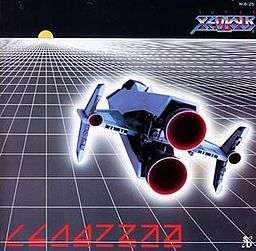Super Xevious
Super Xevious[lower-alpha 1] is a vertically scrolling shooter arcade game developed by Namco and released in 1984. It is an updated version of Xevious, published a year prior, and the second entry in the Xevious series. It was created as a response to the overwhelming success of the original in Japan, appealing to veteran players specifically.
| Super Xevious | |
|---|---|
 Japanese flyer | |
| Developer(s) | Namco |
| Publisher(s) | Namco |
| Designer(s) | Masanobu Endō |
| Series | Xevious |
| Platform(s) | Arcade, Sharp X68000 |
| Release | Arcade
|
| Genre(s) | Scrolling shooter |
| Mode(s) | Single-player, 2 players alternating turns |
| Cabinet | Upright, cocktail |
| Arcade system | Namco Galaga |
| CPU | 3 × Z80 @ 3.072 MHz |
| Sound | Namco WSG @ 3.072 MHz Namco 54XX @ 1.536 MHz |
| Display | Raster, 224 x 288 (vertical) |
Like the original game, the player controls a starship known as the "Solvalou", equipped with two weapons: an "air zapper" to defeat flying enemies, and a "blaster bomb" to destroy ground-based enemies. It runs on the Namco Galaga arcade board. New enemy types include metallic Galaxian flagships. Some of these revert the player's score to zero if destroyed. Critical reception was positive, and is cited as an improvement over the original.
It has been ported to the Sharp X68000 and PlayStation, alongside inclusion in several Namco collections.
Gameplay

The gameplay is that of the original Xevious except this time it is a little more difficult. Several new enemies have also been introduced: a silver Galaxian flagship, a rare silver Galaga "scorpion" ship, two jet planes (one indestructible), a helicopter, and a dark yellow Tank Battalion tank. The tank, one of the jets, and the helicopter will reset the player's score to 0 if the player destroys them, but the tank will award 10,000 points if the player picks it up by flying over it[1]. The hidden Sol Citadel towers and Rally-X Special Flags are located in different places.
Soundtrack
The game's electronic chiptune music was composed by Yuriko Keino and Junko Ozawa.[2] Former Happy End and Yellow Magic Orchestra member Haruomi Hosono recorded an arranged dance/synthpop version of the game's theme tune,[3] which was released in Japan by Alfa Records' Yen label as a 12" single on August 29, 1984.[2] The single was also released in Europe by Pick Up Records that same year.[3]
Notes
References
- https://strategywiki.org/wiki/Super_Xevious
- "Super Xevious (12" Single)". VGMdb. Retrieved 7 August 2012.
- "Haruomi Hosono – Super Xevious". Discogs. Retrieved 7 August 2012.
External links
- Super Xevious at the Killer List of Videogames
- Super Xevious at the Arcade History database